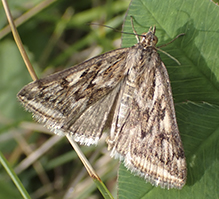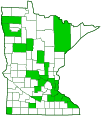alfalfa webworm moth
(Loxostege cereralis)
Conservation • Description • Habitat • Ecology • Distribution • Taxonomy
|
||||||||
| Hodges # | 5017 |
|||||||
Conservation Status |
||||||||
| IUCN Red List | not listed |
|||||||
| NatureServe | NNR - Unranked SNR - Unranked |
|||||||
| Minnesota | not listed |
|||||||
Description |
||
Alfalfa webworm moth is a common, small to medium sized, roughly triangular (deltoid) moth. It occurs throughout the contiguous United States, but it is absent from the Great Basin, and it is mostly absent from the southeast. It also occurs across southern Canada and in Mexico. The larvae feed on the leaves of a wide variety of plants, including alfalfa, sugar beet, vegetables, and other agricultural crops. They prefer broadleaved species to grains and other grasses. When they occur in large numbers, they can destroy an entire crop. They sometimes migrate in masses, like armyworms, from decimated fields. Adults are found from May to September in prairies, meadows, weedy fields, gardens, and agricultural crops. Adults are ⅜″ to ½″ (10 to 13 mm) in length and have a 1 3⁄16″ to 1⅜″ (30 to 34 mm) wingspan. Moth sizes are sometimes given in terms of forewing length, which for this moth is ½″ to ⅝″ (13 to 16 mm). The body is slender. The sensory mouthparts (labial palps) are moderately long and are projected forward. The compound eyes are large. The simple eyes (ocelli) are small but well developed. The forewing is broadly triangular and pale gray, grayish brown, or brown, with dark brown to black lines and streaks, and tan shading. In the basal area there is a long, longitudinal, black dash at the middle and a pale patch at the wing base on the inner margin. The middle part of the postmedial (PM) line is expanded on the veins into small, black, narrow, forward-pointing wedges. At the leading edge (costal margin), the PM line is expanded into a broad, black or dark brown patch. There is a pale patch between the round spot in the upper median area (orbicular spot) and the kidney-shaped spot (reniform spot) in the lower median area, and there is sometimes a black dash connecting the spots. The subterminal (ST) band is sharply defined and yellowish or tan. It is evenly tapered at both the inner and costal margins. The terminal line is relatively broad and is shadowed on the inside by a similar but more diffuse line. The hindwing is gray or brownish gray with a variable amount of dark shading along the veins and near the outer margin. On the middle legs, the fourth segment (tibia) is thickened. |
||
Size |
||
Total length: ⅜″ to ½″ (10 to 13 mm) Wingspan: 1 3⁄16″ to 1⅜″ (30 to 34 mm) |
||
Similar Species |
||
Beet webworm moth (Loxostege munroealis) lacks the black wedges and streaks. The |
||
Habitat |
||
Prairies, meadows, weedy fields, gardens, and agricultural crops |
||
Ecology |
||
Season |
||
Two or more generations per year in most areas: May to September |
||
Behavior |
||
First and second stage (instar) larvae skeletonize leaves, eating the tissue and leaving the major veins. Later instars feed communally in webs and consume entire leaves. They often make a silk tube leading from their feeding site to the ground or other protected site. Adults are active at night and are attracted to light. |
||
Life Cycle |
||
The eggs are flat and are laid end to end in a few overlapping rows. |
||
Larva Food |
||
A wide variety of mostly broadleaved plants |
||
Adult Food |
||
|
||
Distribution |
||||
|
Sources Biodiversity occurrence data published by: Minnesota Biodiversity Atlas (accessed through the Minnesota Biodiversity Atlas Portal, bellatlas.umn.edu, 12/17/2023). |
|||
| 12/17/2023 | ||||
Occurrence |
||||
Common and widespread |
||||
Taxonomy |
|||
Order |
Lepidoptera (Butterflies and Moths) | ||
Superfamily |
Pyraloidea (Pyralid and Crambid Snout Moths) | ||
Family |
Crambidae (Crambid Snout Moths) | ||
Subfamily |
Pyraustinae | ||
Tribe |
Pyraustini | ||
Genus |
Loxostege | ||
Synonyms |
|||
Eurycreon cereralis |
|||
Common Names |
|||
alfalfa webworm (larva) alfalfa webworm moth (adult) |
|||
Glossary
Costal margin
The leading edge of the forewing of insects.
Instar
The developmental stage of arthropods between each molt; in insects, the developmental stage of the larvae or nymph.
Ocellus
Simple eye; an eye with a single lens. Plural: ocelli.
Palp
Short for pedipalp. A segmented, finger-like process of an arthropod; one is attached to each maxilla and two are attached to the labium. They function as sense organs in spiders and insects, and as weapons in scorpions. Plural: palpi or palps.
Postmedial (PM) line
A thin line separating the median area and the postmedial area of the forewing of Lepidoptera.
Tibia
The fourth segment of an insect leg, after the femur and before the tarsus (foot). The fifth segment of a spider leg or palp. Plural: tibiae.
Visitor Photos |
|||||
Share your photo of this insect. |
|||||
| This button not working for you? Simply email us at info@MinnesotaSeasons.com. Attach one or more photos and, if you like, a caption. |
|||||
Babette Kis |
|||||
Loxostege cereralis alfalfa webworm moth Loxostege cereralis, alfalfa webworm moth, Barnes Prairie Remnant, Racine Co., WI August 31, 2021. |
 |
||||
MinnesotaSeasons.com Photos |
|||||
|
|||||

Slideshows |
||

Visitor Videos |
|||
Share your video of this insect. |
|||
| This button not working for you? Simply email us at info@MinnesotaSeasons.com. Attach a video, a YouTube link, or a cloud storage link. |
|||
Other Videos |
|||
| Alfalfa Webworm Moth (Crambidae: Loxostege cereralis) Dorsal view Carl Barrentine |
|||
About
Oct 7, 2011 Photographed at Grand Forks, North Dakota (07 October 2011). Thank you to Maury Heiman (@Bugguide.net) for confirming the identity of this specimen! |
|||
| Alfalfa Webworm Moth (Geometridae: Loxostege cerealis?) Carl Barrentine |
|||
About
Jul 30, 2009 Photographed at Grand Forks, North Dakota (29 July 2009). Shared with NGTv (April 2010). |
|||


Created: 12/16/2023
Last Updated:

